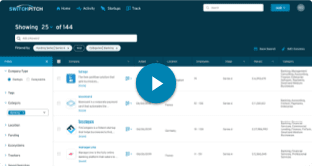
Enterprises are engaging with startups in unprecedented ways. Many enterprises have well-established procedures for tracking startup engagement – AT&T, Unilever, Coca Cola all have large-scale startup engagement programs. However, keeping tabs on the ever changing data – both external and internal – is becoming overwhelming.
We spend a considerable amount of time discussing startup engagement best practices with Fortune 500 companies. Here’s what heads of innovation tell us they prioritize most in startup engagement:
Sourcing innovative startups
Nearly all established corporate innovation teams have well-developed startup ecosystem partnerships. Accelerators, VCs, coworking spaces and universities are among the top sources of referrals.
But limiting partnerships to these sources present challenges. Chiefly among these is tracking startups outside of enterprises’ core focus. More and more, innovation is industry-agnostic: Solutions focused on healthcare have applications in financial services or aerospace & defense. To truly track all relevant startup innovation, enterprises must focus BEYOND their immediate industry, with a global focus.
For example, BAE Systems recently identified a healthcare augmented reality solution – J&F Alliance – that was not focused on aerospace & defense. BAE signed a deal with J&F via the SwitchPitch platform to assemble sensor payloads for UAVs. The partnership was struck because BAE looked beyond defense industry solutions and found the most relevant innovation for its need.
External startup data
Who are the funders, founders, clients? Enterprises use this startup data to evaluate which startups have solutions that can scale. Startup data sources include Crunchbase, Angel List, CB Insights and MatterMark – all of which are useful for investment evaluation.
For business development data, such as startups’ client list, project history, and client ratings, enterprises need to dig deeper. SwitchPitch captures this data specific for business development evaluation, making enterprise / startup engagement more efficient and effective.
Custom startup data
Custom data connects external solutions with internal needs – it shows how startups fit into enterprises’ business units. Data examples include:
- Business Benefit
- Partnership level
- Targeted Use Cases
- Pricing Model
Data may be provided by enterprises – or by startups – depending on the nature of information desired.
One of SwitchPitch’s clients, a leader in the communications industry, uses our custom data to create a pipeline that compares and contrasts how different startups would integrate into their business units.
Startup-managed profiles
When startups create and control their own profiles, interesting things happen. Whole startup teams are engaged; startups’ current client information is up-to-date; even enterprise-specific data can be tracked – meaning that startups can contribute unique data specific to enterprises’ needs / use cases. This marketplace model lends itself to effective, efficient startup engagement.
But often, too many enterprises limit themselves by using the single-sided format of a database. Minus collaboration, minus a global approach. Only through a marketplace like SwitchPitch can enterprises utilize a two-sided platform, enabling a “front door for innovation” – a centralized portal where startups create a profile and engage with enterprises.
Simple Interface
The best tracking systems and procedures are only as good as the inputs. CRMs, spreadsheets and other solutions are designed for general data capture. But all too frequently they don’t deliver the employee engagement necessary for effective data capture.
So how do you encourage employees to track and enter data? Employees should want to engage and invite startups to join the platform. Make the platform intuitive. Make it easy. Make it fun.
Reporting
Showcasing startup tracking data in an intuitive format is key to getting buy-in and ongoing support for innovation programs. Every organization is different and has different metrics, so reporting should be flexible and customized to track and showcase specific initiatives and outcomes. Not only does reporting show what is working, effective reporting also highlights blind spots.
Single Voice
Multiple conversations with different divisions leads to confusion both internally and externally. Startups may be left with the impression that these corporations are not serious or efficient about startup engagement. Nothing kills a deal faster than lack of effective communication. Capturing analysis, notes, emails, custom data, tags – everything relevant – in a SINGLE place is critical to effective startup engagement. In other words, enterprises speaking with a single voice to startups gets deals done.
Conclusion
Startup engagement is a process – starting with scouting and ending with profitable business outcomes. Along the way, there are many paths enterprises may take. To summarize, the critical pieces are:
- Scouting beyond immediate industry
- Multiple data sources – including from startups
- Consistent internal and external communication
Unifying these pieces in a seamless platform will provide a long-term innovation program with tangible and measurable results.


